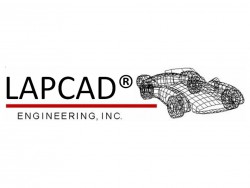LapCAD
LapCAD was first introduced at a conference in Pasadena, in the spring of 1988. It initially functioned as a finite element preprocessor on the Macintosh. Since then, this product has been expanded to include post processing. Support for NASTRAN has
also been added, and in 1991 the first release running on Microsoft’s Windows 3 was introduced. The product has been enhanced through the years, and currently runs on Windows 2000, XP, Vista, 7 and 10.
LapFEA
This integrated product is a combination of the LAPCAD modeler described above, and a finite element solver. This solver supports linear static analysis, modal frequency analysis, and frequency and transient response analysis. This pre-solve-post application also provides step-wise nonlinear geometry capability.
Models can also be exported to the STL file format for 3-D Printing.
LapFEA for Windows is now available in the United States for US$5,000.00. The application includes a pre-processor, a solver, and a post-processor.
Below is a listing of some of the changes included in Release 17:
The following list is un-edited. Some changes apply only to the NASTRAN format.
All information in subject to change without notice.
2000
Added automatic saving of msc/pal2 loads, when geometry is saved. Added option to display attributes for only pre-selected elements. Created new procedure for drawing solid element outline
2001
Added icon for splitting a quad into two quads and two trias. Added icon for conversion of solids to sandwich construction. Added icon for conversion of quads to shear plate/bar construction. Added computation of laminate matrixes. Added optional conversion of RBE2 to bar elements. Added optional conversion of CELAS to bar elements. Created procedures for automatic meshing. Added icon for splitting tria into three quads. Made solids a part of the sharp edge feature. Added support for PELAS properties. Added speed control to view ball. Added control of light source position. Added region and model buttons to lineedit
2002
Added toggles for force and moment reactions. Added toggles for proportional or fixed reaction arrows. Added choice of LapFEA or NASTRAN vector display. Added search for nodes used by single element. Added support for reference point during animation. Added display of surface element material angles. Added support for non-structural mass. Added one line of info to thumbnail display (min & max of thickn & modulus). Added autofuse to node snap feature. Added autolayering for line elements. Added new quad splitter (one quad into quad and two trias, unsymmetric). Added icon for creation of line elements at intersections of surface elements, or at the free edge of surface elements. Added icon for grafting of properties. Added icon for slicing through quads & trias with a plane defined with three reference points. Added test for evaluation of FACTOR DIAGONAL RATIOS, for purpose of providing debug feedback. Added conversion of layer with line elements only, to an RBE2. Added circular option to createloftmacro. Added automatic setup for rigid-body analysis. Added neighbor-adaptive element orientation for surface elements. Added snapping of neighboring nodes to a single node. Added min size to slice feature. Added copy of surface elements to offset distance
2003
Improved auto-meshing of surface elements. Added icon for five-split of quad element. Added icon for seven-split of quad element. Added support for NASTRAN card RFORCE (rotational acceleration). Added facility for icon help messages (-when turned on, an explanation of an icon appears when cursor is held over the icon). Added implementation of wing twist. Added line elements to slice feature. Improved splitting into layers by volume. Added taper to the application of line loads. Added postprocessing of grid point forces. Added postprocessing of load intensities for principal directions. Added procedure for retrieving last session’s volume and file format. Added toggle for drawing and printing to scale. Added scaling of weight for type 5 bar element (fastener type). Added thumbnail view of load cases. Added assignment of RBE3. Added option to assign unique material for each layer
2004
Added icon for splitting hexa into three hexas. Added icon for splitting hexa into four hexas. Added icon for splitting hexa into penta and two hexas. Expanded on improvement of display of bar offsets. Added feature for flatpattern of surface elements. Added support for RBE3. Added display of node numbers for node that are part of the set
2005
Added undo to neighbor mode. Added layer weight to thumbnail display. Added material name of first element in layer, to thumbnail display. Added max/mean/min information to contour label table. Added icon for splitting quad into tria and two quads. Added icon for nastran frequency sweep. Added functions to include all elements atached to the selected node.. Added button to apply current color to active region. Added icon for splitting quad into quad with one adjacent triangle on each side. Added functions to activate all elements adjacent to layer of selected element.. Added display of layer name when drawing the model
2006
Added procedure for postprocessing of composite. Added icon for launching msc/nastran. Added option to group by thickness. Expanded on the automatic surface meshing initiated in 2003. Added icon to tria edit tool tab, for adjustment of mesh made up of trias only
2010
Added support for modal transient response. Added “HILL” criteria. Improved export of MAT1 card. Improved export of CORD2 cards. Added max-min filter
2011
Added export of triangular elements in the stereolithographic (STL) file format, ready for export to a 3-D Printer. The application breaks up quad elements into triangles. It also converts solid elements to surfaces, removes internal surfaces, and then converts remaining elements to triangular ones.Added option to convert solids to external surfaces. Added option to vector orientation
2012
Added icon for removal of internal surfaces for solids, by layer
2013
Assigned parent material properties when undefined.
2017
Compiled the modeler segment of LapFEA to a 64 bit application and expanded the nodal capacity to 300,000



